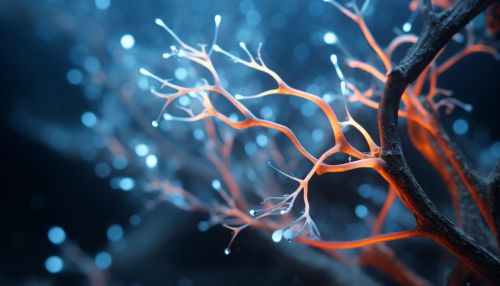Dendritic Spine
Introduction
Dendritic spines are small, bulbous structures that protrude from the dendrites of neurons in the brain. They are the primary sites of synaptic connections between neurons, and play a crucial role in the transmission of electrical signals within the brain. Dendritic spines are highly dynamic, changing in shape, size, and number in response to various factors, including neuronal activity and learning. This plasticity is thought to underlie many aspects of learning and memory.
Structure and Function
Dendritic spines are typically composed of a bulbous head connected to the dendrite by a thin neck. The head of the spine contains a post-synaptic density (PSD), a protein-rich region where neurotransmitter receptors are concentrated. The neck of the spine acts as a diffusional barrier, isolating the biochemical reactions occurring within the spine head from the rest of the dendrite.
The primary function of dendritic spines is to receive and integrate synaptic inputs from other neurons. Each spine typically receives input from a single axon, although multiple inputs can converge on a single spine. The shape and size of the spine can influence the strength of the synaptic connection, with larger spines generally associated with stronger synapses.


Plasticity
Dendritic spine plasticity refers to the ability of spines to change in shape, size, and number in response to neuronal activity. This plasticity is thought to underlie many aspects of learning and memory. For example, during learning, new spines can form and existing spines can grow in size, strengthening the synaptic connections between neurons. Conversely, during forgetting, spines can shrink or be eliminated, weakening these connections.
There are two main forms of dendritic spine plasticity: structural plasticity and functional plasticity. Structural plasticity involves changes in the physical structure of the spine, such as changes in spine size or the formation or elimination of spines. Functional plasticity involves changes in the strength of the synaptic connection, such as changes in the number or type of neurotransmitter receptors in the spine.
Role in Disease
Abnormalities in dendritic spine structure and function have been implicated in a number of neurological and psychiatric disorders. For example, in Alzheimer's disease, there is a loss of dendritic spines in certain regions of the brain, which is thought to contribute to the cognitive deficits associated with the disease. Similarly, in schizophrenia, there are changes in spine density and morphology, which may underlie some of the cognitive and behavioral symptoms of the disorder.
In addition, mutations in genes that regulate dendritic spine development and plasticity have been linked to several neurodevelopmental disorders, including autism and Fragile X syndrome. These findings suggest that dendritic spines play a crucial role in brain development and function, and that disruptions in spine structure or function can lead to neurological and psychiatric disease.
